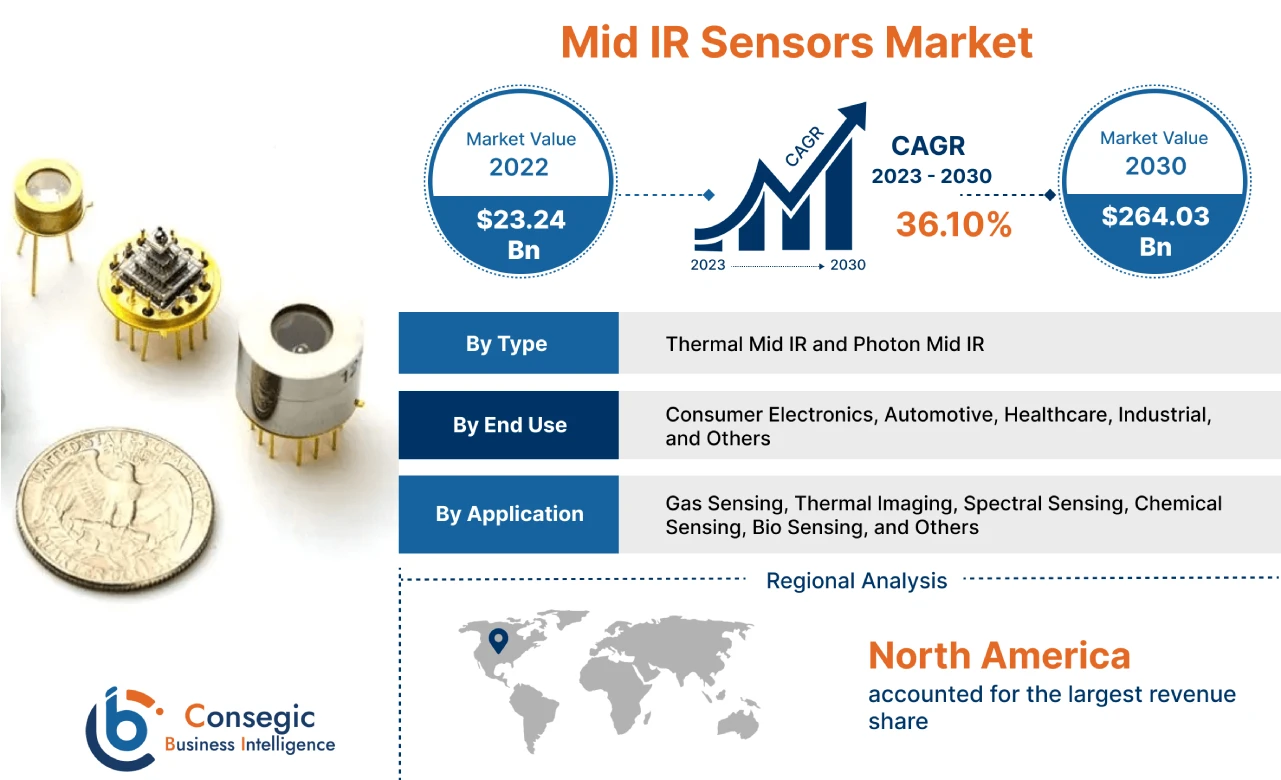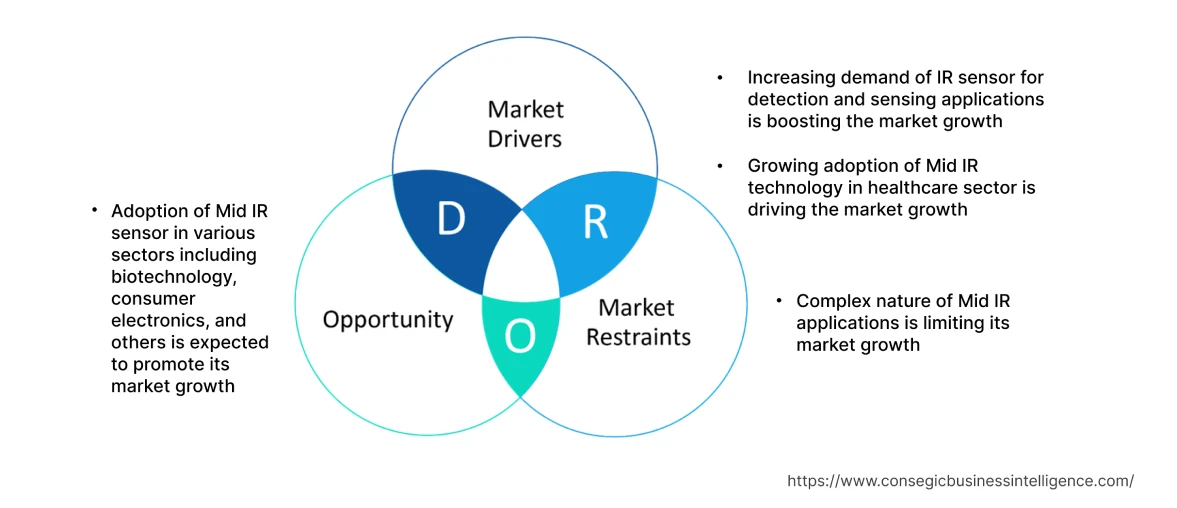Mid IR Sensors Market Introduction :
Mid IR Sensors Market is estimated to reach over USD 264.03 Billion by 2030 from a value of USD 23.24 Billion in 2022, growing at a CAGR of 36.10% from 2023 to 2030.
Mid IR Sensors Market Definition & Overview:
Infrared sensor is a type of sensor being used in wireless technology to detect nearby surroundings and create a remote-control function. Moreover, Mid infrared sensors utilize infrared radiation of wavelength between 3 micrometers to 6 micrometers that lies within visible and microwave regions of electromagnetic spectrum. Furthermore, the IR spectrum is trifurcated into three regions depending upon the wavelength, i.e., Near IR, Mid IR, and Far IR. Among which Mid IR has wide applications among industries including consumer electronics, healthcare, aerospace and defense, and others.
Mid IR Sensors Market Insights :
Key Drivers :
Increasing demand of IR sensor for detection and sensing applications is boosting the market growth
Mid IR technology is widely adopted by the consumer electronics industry for various applications including motion detection and sensing. The key ability of IR sensors to detect fluctuation in the infrared radiation emission by objects is promoting the market growth of Mid IR sensors. Key factors including ability of Mid IR to detect any changes in the wavelength, alternatively impossible for devices emitting visible light during low light conditions is further driving the market growth for Mid IR sensors.
Furthermore, Mid IR sensors are capable of detecting heat signatures of objects that allows devices to detect motion more accurately which tends to drive the demand for Mid IR sensors in IR based cameras. In addition, Mid IR sensors applications such as in smart building for security and monitoring is further enhancing its market growth. For instance, ALTA RETAIL LLC is offering MIR-IR100 wireless PIR motion detector based on operating systems including iOS and Android.
Growing adoption of Mid IR technology in healthcare sector is driving the market growth
Mid IR technology has wide applications in the healthcare sector including monitoring patients, disease diagnosis, analysis of biological samples and others. In addition, technology is also used for procedures including noninvasive imaging of tissues cells, and organs. The procedure allows gathering of data such as tissue structure and molecular distributions that helps in further research and diagnosis of disease among patients. Thus, owing to aforementioned factors including data analysis and sampling of information for applications including drug testing and diseases diagnosis is promoting the market growth of Mid IR in healthcare sector.
Key Restraints :
Complex nature of Mid IR applications is limiting its market growth
Mid IR technology has a few of the outnumbered complexities that limit its market growth including limited depth penetration, complex instruments, interference by other objects, limited availability, among others. Mid IR wavelength has limited penetration depth in biological tissue owing to absorption factor, thus making the research process more complex. In addition, complex instruments including research and measuring devices coupled with their maintenance, development and operation tends to be a tedious task that limits the market growth of Mid IR sensors.
Moreover, Mid IR are vulnerable to interference from different mediums including solid, vapor, gas, and liquid which is subjected to produce false or inaccurate reading in the devices thus causing misalignment and calculations. Thus, owing to the aforementioned complex nature involved in the varied applications of Mid IR is slowing the market growth.
Future Opportunities :
Adoption of Mid IR sensor in various sectors including biotechnology, consumer electronics, and others is expected to promote its market growth
Mid IR technology is rapidly evolving and is expected to be utilized in various other applications in the sectors including healthcare, consumer electronics, and others is expected to promote its market growth. In the field of biotechnology, such as neurological research, Mid IR sensor is projected to bring revolution. Mid IR imaging technology is expected to provide understanding in the functioning of brain and neurological disorders. Moreover, insights into molecular changes associated with conditions including diseases such as Parkinson and Alzheimer's will further enhance the medicinal therapeutics.
Furthermore, factors including integration of Mid IR sensors in wearable devices for monitoring and detections of vital stats associated with human body including heart rate, pulse, oxygen level, and others in a more proficient method will further boost its market growth.
Mid IR Sensors Market Report Insights :
| Report Attributes | Report Details |
| Study Timeline | 2017-2030 |
| Market Size in 2030 | USD 264.03 Billion |
| CAGR (2023-2030) | 36.10% |
| By Type | Thermal Mid IR and Photon Mid IR |
| By Application | Gas Sensing, Thermal Imaging, Spectral Sensing, Chemical Sensing, Bio Sensing, and Others |
| By End Use | Consumer Electronics, Automotive, Healthcare, Industrial, and Others |
| By Region | North America, Europe, Asia Pacific, Latin America, and Middle East & Africa |
| Key Players | Honeywell International, Hamamatsu Photonics K.K., Daylight Solutions, Cascade Technologies, M Squared Lasers Limited, Teledyne FLIR LLC, IPG Photonics Corporation, Changchun New Industries Optoelectronics Tech. Co., Ltd. |
Mid IR Sensors Market Segmental Analysis :
Based on the Type :
Based on the type, the market is bifurcated into Thermal Mid IR and Photon Mid IR. The Thermal Mid IR segment accounted for the largest revenue share in the year 2022. Thermal Mid IR technology utilizes heat emissions from objects to provide reading or data to the installed device. In general applications including temperature detection, thermal imaging, identification of heat source, and monitoring of energy source is boosting its marker growth. Moreover, its applications in sectors including building inspection, industrial maintenance, security surveillance, and others are promoting the market growth of thermal Mid IR sensors.
The Photon Mid IR segment is anticipated to register the fastest CAGR growth during the forecast period. Photon Mid IR technology applies the utilization of lasers and other photon sources to generate and detect Mid IR radiation. The technology is often employed for specialized applications including medical imaging, chemical analysis, scientific research, and others. Furthermore, with the rapid rise in the development of technology and healthcare sectors is expected to promote the Mid IR sensor in the field of diagnostic, material analysis, and others.
Based on the Application :
Based on the Application, the market is bifurcated into reference Gas Sensing, Thermal Imaging, Spectral Sensing, Chemical Sensing, Bio Sensing, and Others. The gas sensing segment accounted for the largest revenue share in the year 2022. Moreover, the segment is anticipated to growth during the forecast period owing to its popularity among sectors including chemical, oil and gas, and others. Gas sensing devices are widely applied in industries including detection of ammonia in cold storage plants, warehouses, oil refineries, and others.
Moreover, the aforementioned sectors are also projected to grow during the forecast period owing to rising demand for food and energy among growing populations.
Based on the End-Use :
Based on the End Use, the market is segregated into Consumer Electronics, Automotive, Healthcare, Industrial, and Others. The industrial segment accounted for the largest revenue share of 35.7% in the year 2022. The segment is also expected to grow with the fastest CAGR during the forecast period. Owing to the increasing demand for applications including drug formulation analysis, quality control, bioprocessing, material analysis, and others. Moreover, industrial applications including mineral and ore analysis by means of spectroscopy is further driving the market growth of the segment and is also projected to grow during the forecast period.
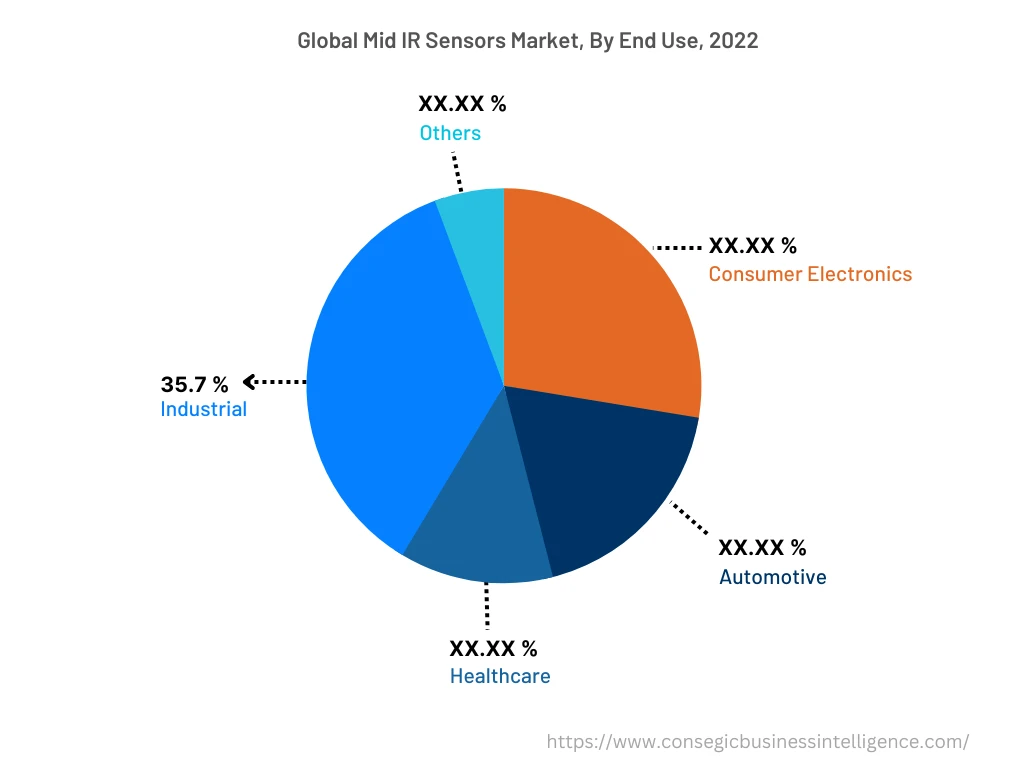
Based on the Region :
The regional segment includes North America, Europe, Asia Pacific, Middle East and Africa, and Latin America.
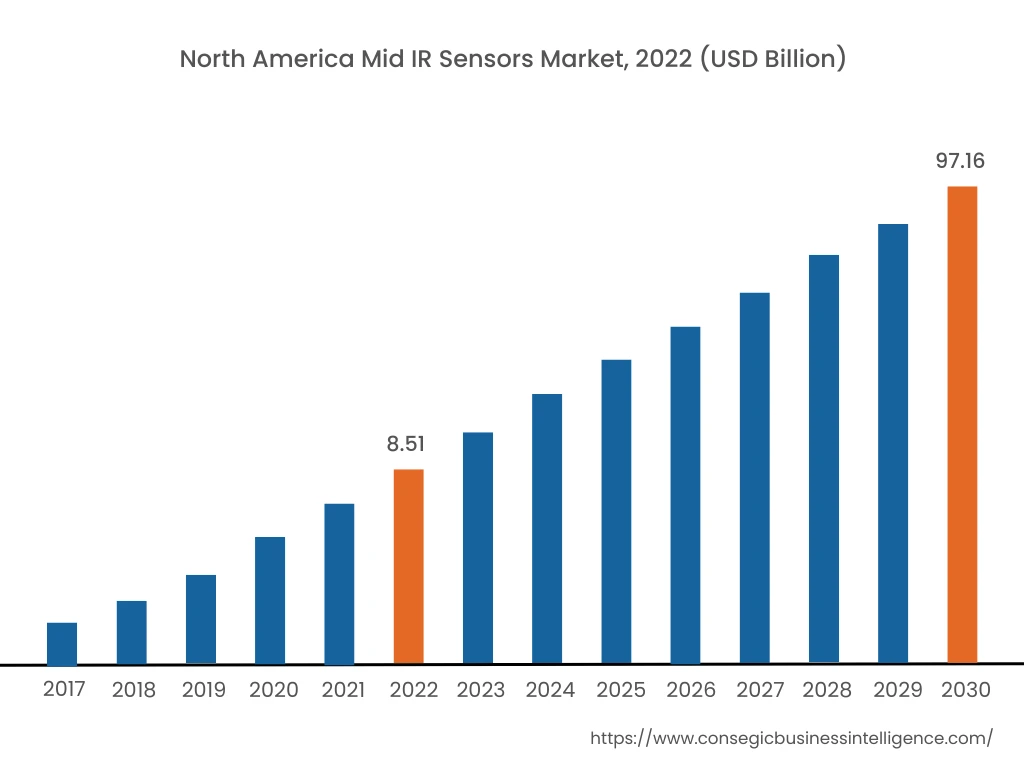
North America accounted for the largest revenue share of USD 8.51 billion in 2022 and is expected to reach USD 97.16 billion by 2030, registering a CAGR of 36.2% during the forecast period. In addition, in the region, the U.S. accounted for the maximum revenue share of 58.7% in the same year. The adoption of Mid IR sensors in the North American region is primarily driven by technological advancement in the region including healthcare and medical applications, growth within industrial and process control, collaboration, and partnerships. Moreover, increasing investment in research and development by companies to develop new products and services to meet industry needs is promoting the market growth for Mid IR sensor.
Asia-Pacific is expected to register fastest CAGR growth of 36.5% during the forecast period. The rising pace of industrialization and development is creating lucrative opportunities for market growth in the region. Moreover, factors including the growth of multiple industries including pharmaceuticals, environmental monitoring, energy, food and agriculture, and others. In addition, government initiatives including promotion and adoption of advanced technologies to boost the economies at large scale is further expected to drive the market growth for Mid IR during the forecast period.
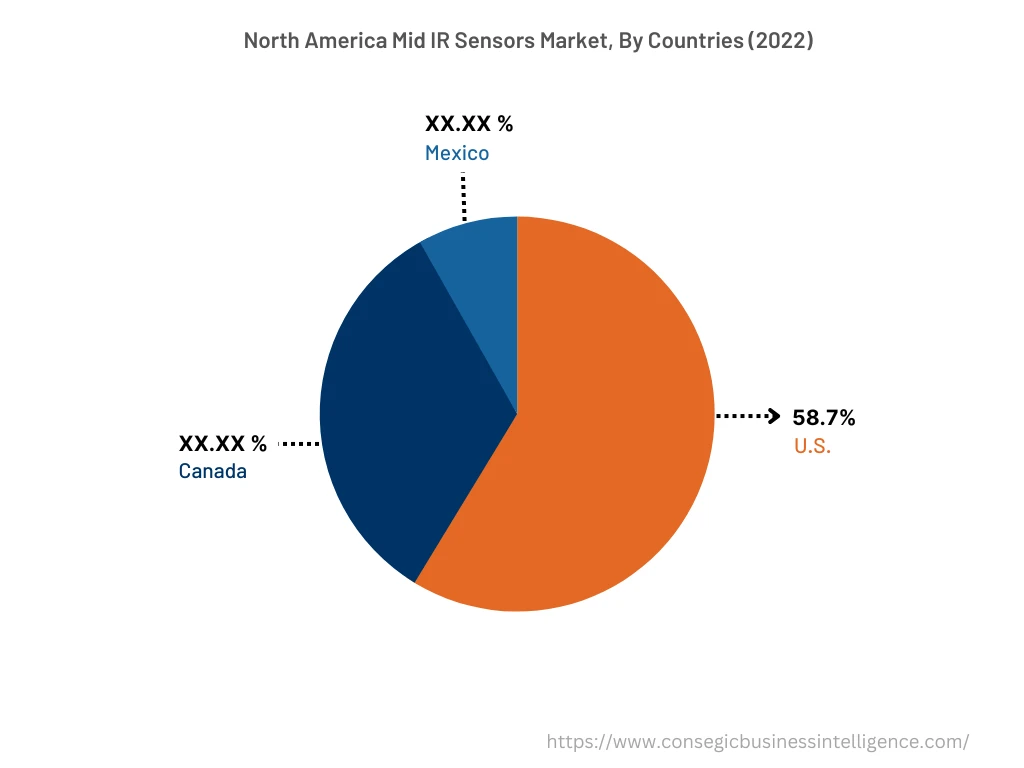
Top Key Players & Market Share Insights:
The Mid IR Sensors Market is highly competitive with major players providing Mid IR Sensors Market to the national and international markets. Key players are adopting several strategies in research and development (R&D), product innovation, and application launches to hold a strong position in Mid IR Sensors Market. Key players in the Mid IR Sensors Market include -
- Honeywell International
- Hamamatsu Photonics K.K.
- IPG Photonics Corporation
- Changchun New Industries Optoelectronics Tech. Co., Ltd.
- Daylight Solutions
- Cascade Technologies
- M Squared Lasers Limited
- Teledyne FLIR LLC
Key Questions Answered in the Report
What is Mid IR Sensors Market? +
Mid IR Sensors Market a type of sensor being used in wireless technology to detect nearby surroundings and create a remote control function.
What specific segmentation details are covered in the Mid IR Sensors Market report, and how is the dominating segment impacting the market growth? +
For instance, by type segment has witnessed thermal Mid IR as the dominating segment in the year 2022, owing to temperature detection convenience offered by the devices to the end users.
What specific segmentation details are covered in the Mid IR Sensors Market report, and how is the fastest segment anticipated to impact the market growth? +
For instance, by end use segment has witnessed industrial segment as the fastest-growing segment during the forecast period due to the rising adoption of advanced technologies by the industries to enhance the safety and productivity of manufacturing plants.
Which region/country is anticipated to witness the highest CAGR during the forecast period, 2023-2030? +
Asia-Pacific is anticipated to register fastest CAGR growth of 36.5% during the forecast period due to rapid pace of industrialization and growth of multiple industries including energy, oil and gas, pharmaceutical, and others.
